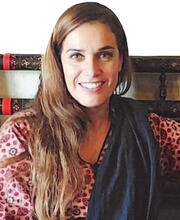Aurore Didier
CNRS: UMR7041-ArScAn
2014 Grant Recipient

The site of Miri Qalat and the Kech-Makran (Balochistan, Pakistan) during the second half of the 3rd millennium BC
Dr. Aurore Didier is an archaeologist and researcher in charge of the “Indus-Balochistan” programme at the French National Center for Scientific Research (CNRS), Laboratory “Archaeology and Sciences of Antiquity” (UMR7041-ArScAn). Since 2013, she has been director of the French Archaeological Mission in the Indus Basin with current projects in Sindh and Balochistan. Her research interests are societies, material cultures and interactions in South Asia during Protohistory with a focus on the Bronze Age communities in the Indo-Iranian Borderlands (3rd millennium BCE) and the Indus Valley Civilization (2500-1900 BCE).
Dr. Didier obtained a PhD in Archaeology at the University of Panthéon-Sorbonne, Paris. She has participated to excavations and surveys in Kech-Makran, Balochistan Pakistan, with the French Archaeological Mission in Makran led by Dr. Roland Besenval and collaborated in publication work by Dr. Jean-François Jarrige and the French Mission to Indus who excavated major archaeological sites in Pakistani Balochistan (Mehrgarh, Nausharo, Pirak). She is the author of several articles on the Archaeology of the Indo-Iranian Borderlands and a monograph on the Early Bronze Age pottery of Kech-Makran. She has also participated in various excavation projects in Ladakh, India, Turkmenistan and the Sultanate of Oman.
Dr. Didier is the lead researcher of this Shelby White and Leon Levy Program project on Miri Qalat and Kech-Makran region during the second half of the 3rd millennium BCE. She has studied the material and the data of Miri Qalat, Excavation I, and archaeological surveys carried out under the supervision of the late Dr. Roland Besenval. Her team includes researchers who participated in the archaeological campaigns at Miri Qalat.
